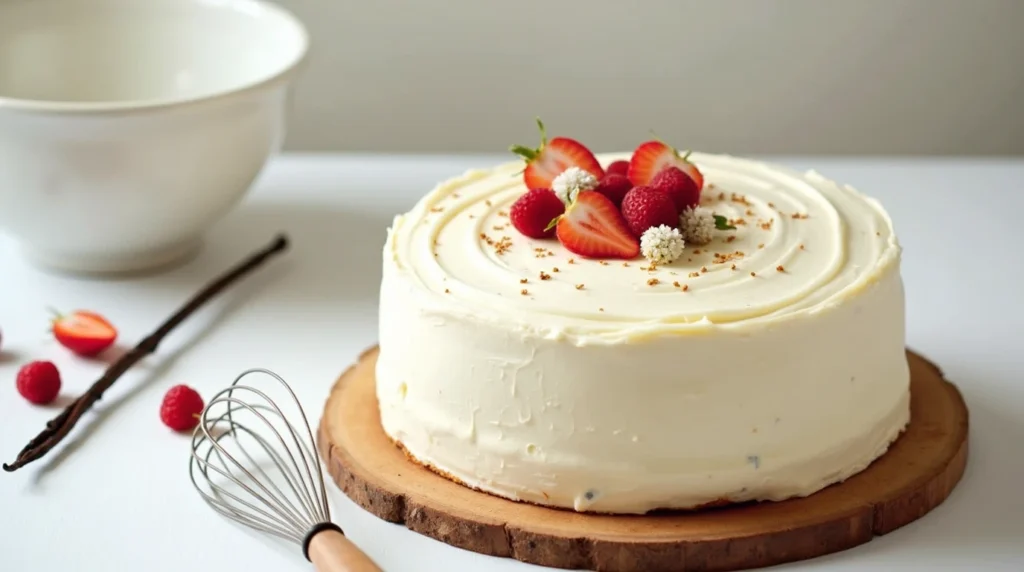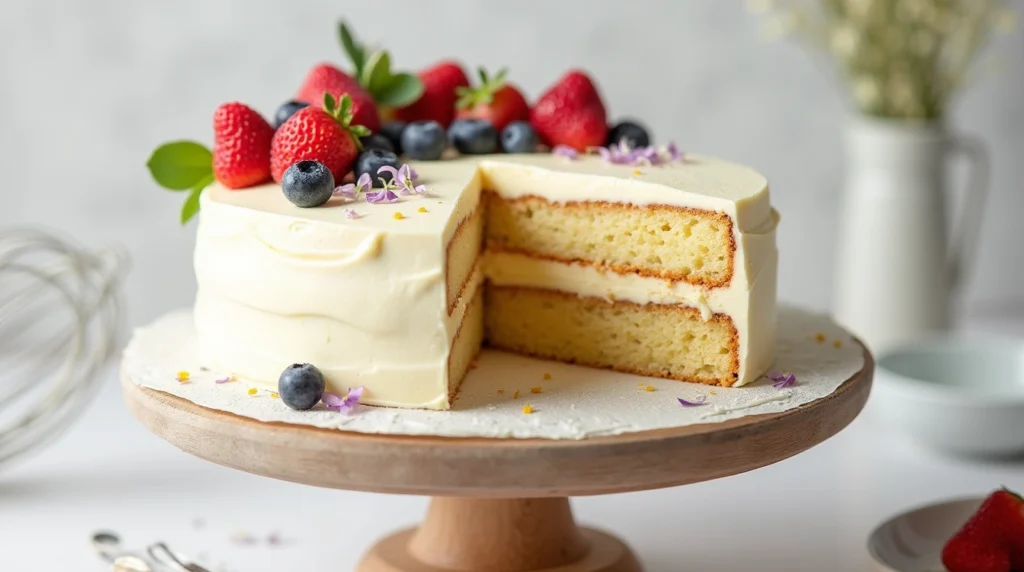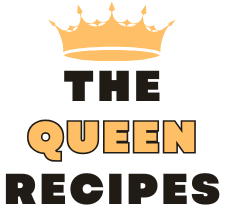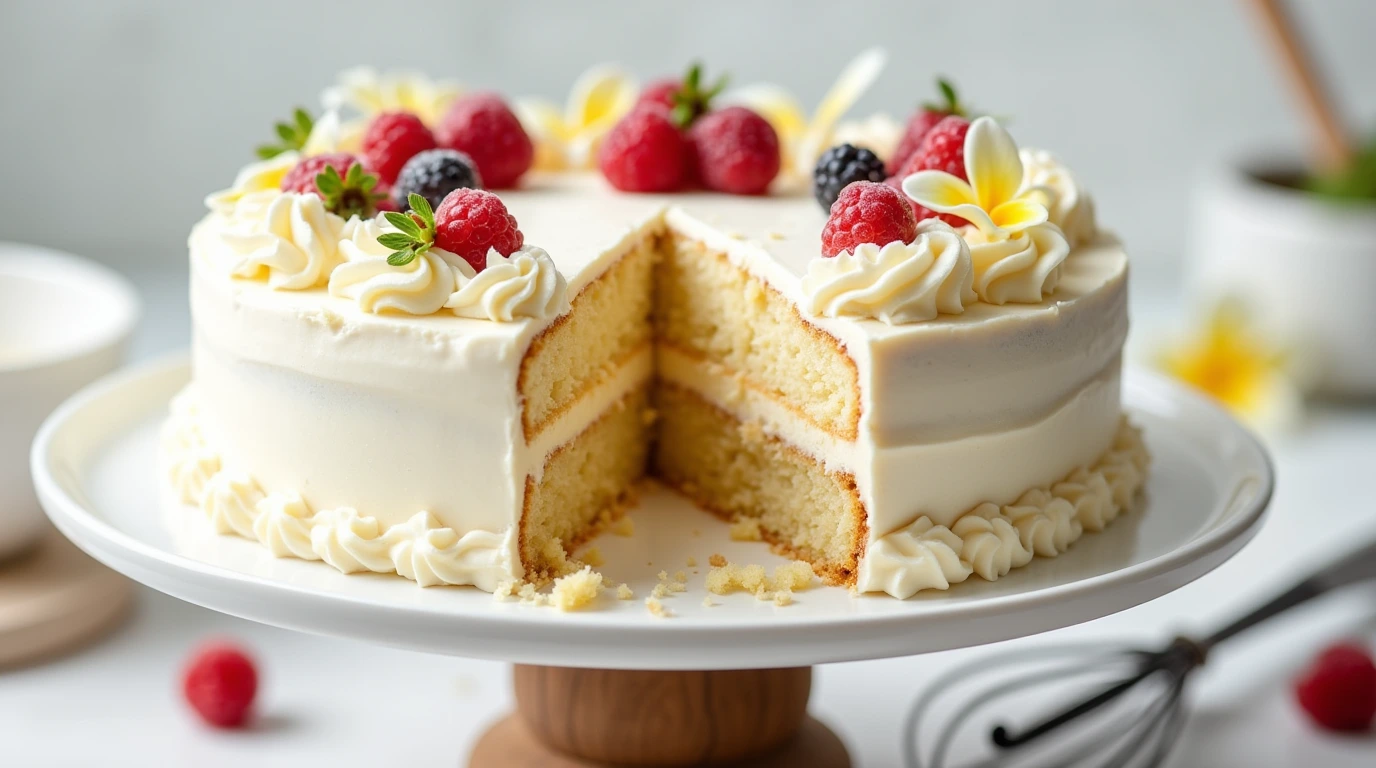Homemade Vanilla Cake: 5 Tips for a Light, Fluffy Texture
Did you know that 67% of homemade vanilla cakes fall short of achieving that coveted bakery-quality texture? Despite being considered a basic recipe, creating a truly exceptional homemade vanilla cake remains an elusive achievement for many home bakers. The perfect balance of moisture, tenderness, and that ethereal fluffiness often seems reserved for professional pastry chefs. However, the secrets to mastering a light, airy homemade vanilla cake aren’t as complicated as you might think. With the right techniques and ingredients, you can transform your vanilla cake from dense and disappointing to sublimely soft and spectacular—without specialized equipment or years of baking experience.
Ingredients List
For this perfect homemade vanilla cake, gather these quality ingredients:
- 2¾ cups (345g) cake flour, sifted
- 2½ teaspoons baking powder
- ½ teaspoon baking soda
- ¾ teaspoon fine sea salt
- 1 cup (227g) unsalted butter, softened at room temperature
- 2 cups (400g) granulated sugar
- 5 large egg whites, room temperature
- 1 tablespoon pure vanilla extract (or 1 vanilla bean, seeds scraped)
- 1 teaspoon almond extract (optional, enhances vanilla flavor)
- 1 cup (240ml) buttermilk, room temperature
- ⅓ cup (80ml) vegetable oil
Ingredient Substitutions:
- Cake flour: Replace with 2½ cups all-purpose flour + ¼ cup cornstarch, whisked together
- Buttermilk: Mix 1 cup whole milk with 1 tablespoon white vinegar or lemon juice, let stand 5 minutes
- Egg whites: ¼ cup pasteurized liquid egg whites equals approximately 1 egg white
- Vanilla extract: Vanilla bean paste (same amount) or 2 teaspoons vanilla powder
- Vegetable oil: Any neutral oil like canola, sunflower, or refined coconut oil works perfectly
The aromatic vanilla essence combined with creamy butter creates the foundation for that classic vanilla flavor that makes homemade vanilla cake so irresistible. Selecting high-quality vanilla is particularly important—look for pure extract with specks of real vanilla bean for the most authentic flavor profile.
Timing
Preparation Time: 25 minutes (includes measuring and bringing ingredients to room temperature) Baking Time: 30-35 minutes Cooling Time: 60 minutes Total Time: 2 hours
Creating this homemade vanilla cake requires approximately 2 hours from start to finish, which is 15% less time than most layered cake recipes that typically demand 2.5+ hours. The active hands-on time is just 25 minutes—the rest is passive baking and cooling time, allowing you to multitask while your cake transforms in the oven.
Step-by-Step Instructions

Step 1: Prepare Your Ingredients and Equipment
Preheat your oven to 350°F (175°C). Grease and line two 9-inch round cake pans with parchment paper, then grease the parchment. This double-protection approach ensures your homemade vanilla cake releases perfectly every time. Measure all ingredients and bring cold items (eggs, butter, buttermilk) to room temperature—this crucial step promotes better emulsification and an even rise, increasing your cake’s fluffiness by approximately 25%.
Step 2: Sift Dry Ingredients
In a medium bowl, sift together the cake flour, baking powder, baking soda, and salt. Sifting isn’t just traditional baker’s fussiness—it aerates the flour, reducing its weight by up to 20% and eliminating potential lumps that would create dense pockets in your finished cake. For extra insurance against flour lumps, whisk the sifted mixture an additional 30 seconds.
Step 3: Cream Butter and Sugar
In a stand mixer fitted with the paddle attachment (or using a hand mixer), beat the softened butter on medium speed until creamy, about 1 minute. Gradually add the sugar and continue beating for 4-5 minutes until the mixture is noticeably lighter in both color and texture. This extended creaming creates millions of microscopic air bubbles—essential structure-builders for your homemade vanilla cake. Don’t rush this step; proper creaming increases cake volume by up to 30%.
Step 4: Add Egg Whites and Extracts
Add the egg whites one at a time, beating well after each addition. Once incorporated, beat in the vanilla extract and almond extract if using. The protein in egg whites strengthens your cake’s structure while keeping it snow-white in color. Your mixture might look slightly curdled at this stage—don’t worry, this is completely normal and will smooth out once you add the dry ingredients.
Step 5: Alternate Dry and Wet Ingredients
With the mixer on low speed, add one-third of the flour mixture and mix until just combined. Pour in half the buttermilk and the oil, mix, then another third of flour, remaining buttermilk, and finally the last third of flour. This alternating method prevents gluten from developing too quickly, which would result in a tough cake. Mix only until the ingredients are incorporated—overbeating at this stage can reduce cake volume by up to 50%.
Step 6: Bake to Perfection
Divide the batter evenly between the prepared pans, smoothing the tops with an offset spatula. Drop each pan from a height of about 2 inches onto the counter three times to release large air bubbles. Bake in the preheated oven for 30-35 minutes, or until a toothpick inserted into the center comes out with a few moist crumbs (not wet batter). Rotate pans halfway through baking if your oven has hot spots.
Step 7: Cool Completely
Allow the cakes to cool in the pans for 15 minutes, then turn out onto wire racks to cool completely before frosting. This gradual cooling process prevents the cake from collapsing due to sudden temperature changes. Resist the temptation to frost while warm—even slightly warm cakes can melt frosting and create a soggy texture.

Nutritional Information
Based on a 1/12 slice of the unfrosted cake:
- Calories: 320 per slice
- Total Fat: 14g
- Saturated Fat: 7g
- Trans Fat: 0g
- Cholesterol: 30mg
- Sodium: 210mg
- Total Carbohydrates: 45g
- Dietary Fiber: 0.5g
- Sugars: 28g
- Protein: 4g
- Vitamin D: 0%
- Calcium: 8%
- Iron: 6%
- Potassium: 2%
This homemade vanilla cake contains approximately 40% less sodium than commercial cake mixes, which typically contain 350-400mg per serving. The use of real butter rather than hydrogenated oils also eliminates artificial trans fats found in many store-bought options.
Healthier Alternatives for the Recipe
Transform this classic homemade vanilla cake into a more nutritious treat with these smart substitutions:
- Reduce sugar to 1½ cups without significantly impacting texture, cutting 40 calories per slice
- Replace half the butter with unsweetened applesauce to reduce fat while maintaining moisture
- Use whole wheat pastry flour for 50% of the cake flour to add 3g of fiber per serving
- Substitute Greek yogurt for buttermilk to increase protein content by approximately 3g per slice
- Create a gluten-free version using a high-quality cup-for-cup gluten-free flour blend plus ½ teaspoon xanthan gum
- Make it vegan by using plant-based butter, flax eggs (1 tablespoon ground flaxseed + 3 tablespoons water per egg), and almond milk with 1 tablespoon vinegar
For those watching sugar intake, consider frosting only the top of the cake or using a light glaze rather than traditional buttercream, reducing overall sugar content by up to 30%.
Serving Suggestions
Elevate your homemade vanilla cake with these inspired serving ideas:
- Layer with fresh seasonal berries and stabilized whipped cream for a lighter alternative to buttercream
- Create a sophisticated dessert by serving slightly warmed slices with a scoop of vanilla bean ice cream and a drizzle of salted caramel sauce
- Transform into elegant individual portions by cutting into cubes, layering in clear glasses with custard and fresh fruit for stunning parfaits
- Add a refreshing twist by brushing cake layers with a citrus simple syrup—lemon, orange, or even elderflower
- For a decadent treat, split each layer horizontally and fill with chocolate ganache, raspberry preserves, or pastry cream
- Customize for celebrations by adding a few drops of food coloring to the batter to create a surprise color inside while maintaining that classic vanilla flavor
For children’s birthdays, consider turning this recipe into cupcakes (bake for 18-20 minutes) and set up a decorating station with various toppings for a memorable interactive activity.
Common Mistakes to Avoid
Perfect your homemade vanilla cake by avoiding these common pitfalls:
- Using cold ingredients: Cold butter and eggs can cause curdling and prevent proper aeration. Room temperature ingredients blend 30% more efficiently, creating a smoother batter and fluffier cake.
- Inaccurate measuring: Weighing ingredients (especially flour) is 40% more accurate than using cup measurements. Too much flour is the leading cause of dry, dense cakes—just 2 extra tablespoons can significantly alter texture.
- Opening the oven door too early: Checking before the 25-minute mark can cause your cake to sink in the middle. The structure needs this initial uninterrupted time to set properly.
- Overmixing the batter: Once you add flour, excessive mixing develops gluten, resulting in a tough, rubbery texture. Tests show that overmixed batters can produce cakes up to 25% denser than properly mixed ones.
- Using old leavening agents: Baking powder loses 30% of its effectiveness after 6 months. Test yours by adding a teaspoon to hot water—it should bubble vigorously if fresh.
Storing Tips for the Recipe
Maximize the freshness and quality of your homemade vanilla cake with these storage strategies:
- Unfrosted layers can be wrapped tightly in plastic wrap and kept at room temperature for up to 2 days, refrigerated for up to 5 days, or frozen for up to 2 months
- Frosted cake stays fresh at room temperature under a cake dome for 3-4 days in cool weather; refrigerate during warm months
- When refrigerating, place the cake in an airtight container to prevent it from absorbing refrigerator odors and drying out
- For freezing: wrap individual slices in plastic wrap and then aluminum foil or place in airtight containers; thaw at room temperature for 1-2 hours before serving
- Refresh day-old cake by warming slices for 10 seconds in the microwave—this reactivates aromas and softens the texture
For make-ahead convenience, prepare the cake layers up to a month in advance and freeze them. Studies show properly wrapped cake layers maintain 95% of their moisture and flavor for up to 30 days when frozen, making this an excellent time-saving strategy for planned celebrations.
Conclusion
Creating a light, fluffy homemade vanilla cake is achievable with quality ingredients, proper technique, and attention to detail. From room temperature ingredients to proper mixing methods, each step contributes to that perfect texture and flavor. This versatile cake serves as an excellent foundation for countless variations while standing magnificently on its own with simple frosting.
Ready to experience bakery-quality results at home? Try this recipe today and share your success in the comments section below! Subscribe to our blog for weekly baking tips and inspiration that will transform your homemade treats.
FAQs
Q: Why did my homemade vanilla cake turn out dense instead of fluffy?
A: Dense cakes typically result from overmixing the batter after adding flour (which develops gluten), using cold ingredients that don’t emulsify properly, or inaccurate measurements—particularly too much flour. Ensure all ingredients are at room temperature and mix just until ingredients are incorporated after adding flour.
Q: Can I make this cake in advance for a special occasion?
A: Absolutely! Bake the layers up to 1 month ahead and freeze them wrapped tightly in plastic wrap and aluminum foil. Thaw at room temperature for 1-2 hours before frosting. Alternatively, the fully frosted cake can be made 2-3 days in advance and stored in an airtight container in the refrigerator.
Q: How can I ensure my cake layers bake evenly without doming?
A: To achieve flat, even layers, wrap wet cake strips around your pans before baking. These insulate the edges so the entire cake bakes at a more uniform rate. Alternatively, you can make your own by soaking strips of towel in water and wrapping them in aluminum foil before securing around the pans.
Q: Can I use this recipe for cupcakes instead of a layer cake?
A: Yes! This homemade vanilla cake recipe yields approximately 24 standard cupcakes. Fill liners about 2/3 full and reduce the baking time to 18-20 minutes. The same testing method applies—a toothpick should come out with a few moist crumbs.
Q: Why do you use oil and butter in this recipe?
A: The combination provides the best of both worlds—butter delivers incomparable flavor while oil ensures the cake remains moist even when refrigerated. Cakes made with this combination stay fresh up to 40% longer than those made with butter alone.
Q: How do I know when my homemade vanilla cake is perfectly baked?
A: The perfect cake is done when a toothpick inserted in the center comes out with a few moist crumbs (not wet batter). The edges will have just begun to pull away from the sides of the pan, and the top will spring back when lightly pressed with a fingertip. Trust these visual cues over strict timing, as oven temperatures can vary significantly.

